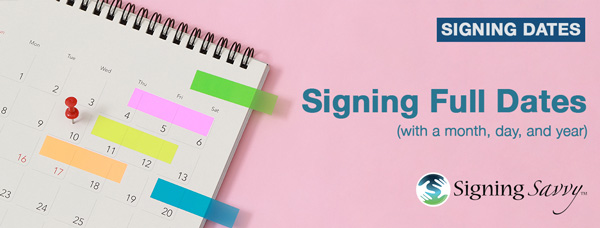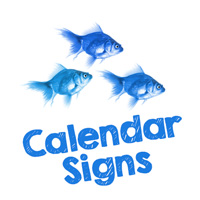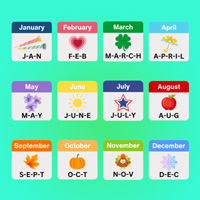An ASL Dictionary
Signing Savvy is a sign language dictionary containing several thousand high resolution videos of American Sign Language (ASL) signs, fingerspelled words, and other common signs used within the United States and Canada.And Much More!
Signing Savvy is an ideal resource to use while you learn sign language. It includes the ability to view signs, build word lists and share them with others, create digital flash cards and quizzes, view ASL sentences, get tutoring, ...and moreSign of the Day - BIRD

Signing Dates – Signing Full Dates (with a month, day, and year)
In this series of articles, I discuss how to sign dates in American Sign Language. In this article, I bring it all together and discuss how to sign the month, day, and year together, aka the full date.
To sign a full date that includes a month, day, and year:
- First, sign the month.
If you need help signing the month, see the article Signing Dates – Signing Months for more information.
- Then, the number for the day of the month.
The dates 1-9 are signed with a twist. The dates 10 and up are simply signed using the number. See the article Signing Dates – Signing the Day of the Month for more information.
- Then, the sign "YEAR".
See the sign for YEAR.
- Then, the numbers for the year.
To sign years, you sign how you would say them, shifting your hand slightly away from your body as you sign each set of numbers. See the article Signing Dates – Signing Years for more information.
Examples of Signing Full Dates
June 12, 2004:
- Sign Description: JUNE (J-U-N-E) + 12 + YEAR + 2-0-0-4
June 12, 2004 (another way):
- Sign Description: JUNE (J-U-N-E) + 12 + YEAR + 20 + 04
October 30, 1971
- Sign Description: OCTOBER (O-C-T) + 30 + YEAR + 19 + 71
December 16, 1937:
- Sign Description: DECEMBER (D-E-C) + 16 + YEAR + 19 + 37
Adding the Day of the Week
If you want to add the name of the day of the week to your full date, such as:
Sunday, January 1, 2012
You simply add the name of the day first. So in the case of the example, you would sign:
SUNDAY, JANUARY (J-A-N) 1 + YEAR + 20 + 12.
If you need help signing the day of the week, see the article Signing Dates – Signing the Day of the Week for more information.
ADVERTISEMENTS
 Brenda Cartwright is a Coda, seasoned interpreter, a master teacher, well known presenter, and author of several best selling sign language and interpreting textbooks from the RID Press. For 35 years Brenda was the Chair of the Sign Language Interpreter Program at Lansing Community College in Lansing, Michigan.
Brenda Cartwright is a Coda, seasoned interpreter, a master teacher, well known presenter, and author of several best selling sign language and interpreting textbooks from the RID Press. For 35 years Brenda was the Chair of the Sign Language Interpreter Program at Lansing Community College in Lansing, Michigan. Signing Dates – Signing the Day of the Month
Signing Dates – Signing the Day of the Month Signing Dates – Signing Years
Signing Dates – Signing Years Signs That Are Close... But Not the Same — Calendar Signs
Signs That Are Close... But Not the Same — Calendar Signs Signing Dates – Signing Months
Signing Dates – Signing Months





